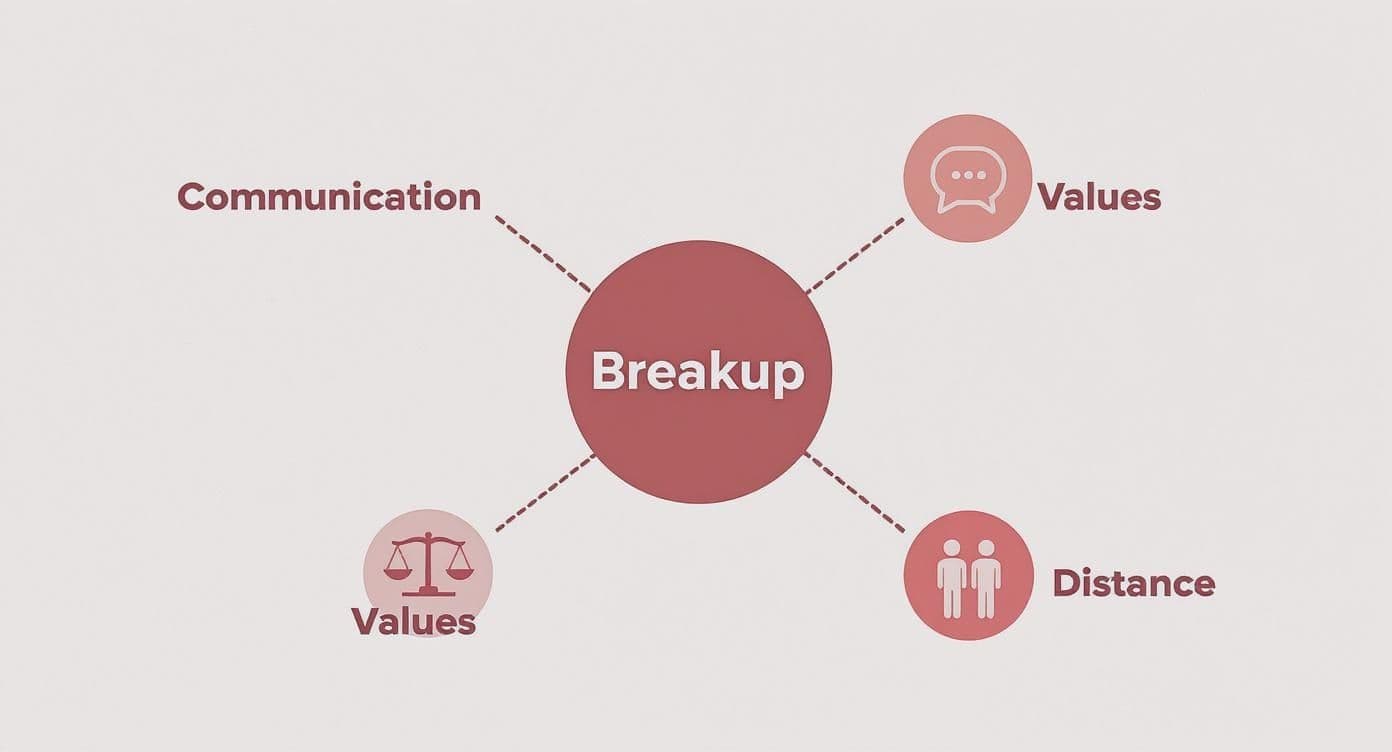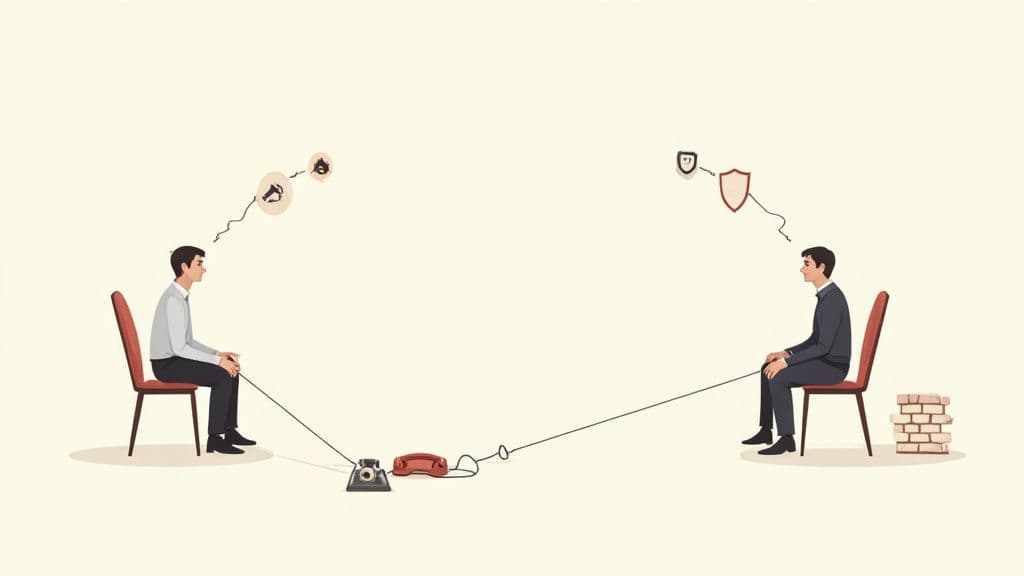Explore why do relationships fail and learn practical steps to strengthen trust, communication, and connection for lasting partnerships.
November 2, 2025 (23d ago)
Why do relationships fail: Causes and Fixes
Explore why do relationships fail and learn practical steps to strengthen trust, communication, and connection for lasting partnerships.
← Back to blog
Why Relationships Fail: Causes & Fixes
Summary: Explore why relationships fail and learn practical steps to strengthen trust, communication, and connection for lasting partnerships.
Introduction
It’s the question that haunts many people after a painful split: why do relationships fail? While every breakup feels deeply personal, the reasons often fall into familiar patterns. This article explains the core causes—communication breakdowns, emotional distance, mismatched values—and offers practical fixes to rebuild trust and connection.
The real reasons most relationships end
When a relationship crumbles, people often replay arguments trying to find a single cause. In reality, most breakups are the predictable outcome of unresolved, ongoing problems that quietly weaken a partnership over time. Think of a relationship like a house: without a solid foundation, small cracks—unspoken needs, resentments, or emotional distance—grow until the structure can’t hold.
An infographic below shows how these core issues interconnect.

The end of a relationship is usually a symptom of deeper troubles: poor communication, different life goals, or a slow emotional drift.
Understanding your core patterns
Some conflicts tie back to deeper life patterns or priorities. Dan Millman’s work in The Life You Were Born to Live suggests that understanding your life path can reveal recurring challenges and strengths. Tools like the Life Purpose App can help identify these patterns and offer insight into why certain dynamics keep repeating.
Understanding core differences can shift your perspective from blame to curiosity—asking how two people’s needs and purposes interact rather than who’s at fault.
Quick guide to common relationship stress points
| Stress Point | Common Symptom | Deeper Issue |
|---|---|---|
| Communication | Constant arguing or total silence | Fear of vulnerability; unmet needs |
| Intimacy | Lack of physical or emotional closeness | Emotional distance; unresolved resentments |
| Values | Disagreements on money, family, or future | Fundamental incompatibility; different life priorities |
| Trust | Jealousy, secrecy, or betrayal | Insecurity; past wounds affecting the present |
| External Pressure | Stress from work, family, or finances | Inability to function as a team; poor support |
Recognizing these tripwires is the first step toward addressing the real problems.
When communication completely breaks down

If a relationship is alive, communication is its lifeblood. When that flow is blocked—especially when vulnerability and listening disappear—the connection begins to wither. This isn’t just about talking more; it’s about the quality of conversation and how safe each partner feels to be honest.
A persistent communication breakdown is one of the most common reasons couples separate. It gradually erodes intimacy, trust, and respect until conversations feel like navigating a minefield.
The Four Horsemen of relationship conflict
Research identifies four destructive communication patterns that reliably predict relationship decline: criticism, contempt, defensiveness, and stonewalling. Recognizing these patterns is the first step toward change.1
- Criticism: Attacking a partner’s character rather than addressing a specific behavior.
- Contempt: Sarcasm, eye-rolling, or mockery that expresses disgust and corrodes respect.
- Defensiveness: Counterattacks or playing the victim instead of taking responsibility.
- Stonewalling: Emotional withdrawal and shutting down, leaving the other partner feeling abandoned.
When these become default interactions, it’s very difficult to feel safe, seen, or valued.
Unspoken expectations and assumptions
Many couples carry an unwritten rulebook about how their partner should behave. When those expectations aren’t communicated, resentment builds. Mismatched expectations fuel the very communication problems that push partners apart.
If you recognize these dynamics, change is possible. Relationship communication exercises and structured conversations can help break toxic patterns and rebuild trust. See practical exercises at the Life Purpose App blog for guided steps and prompts.
The hidden influence of life purpose and core priorities
Sometimes two loving, capable people clash for reasons that seem deeper than communication style—differences in core priorities or life purpose. Dan Millman’s system suggests that people have natural life paths that shape priorities and challenges. When partners’ paths pull in different directions, friction can feel unresolvable.
When core purposes collide
Every life path carries a set of needs and priorities. For example:
- Creative expression vs. structure: One partner pursues innovation and spontaneity; the other seeks stability and order.
- Freedom vs. responsibility: One values independence and change; the other values duty and commitment.
These kinds of mismatches aren’t moral failures; they’re differences in what each person needs to thrive. Recognizing this can shift arguments from blame to mutual understanding.
Discovering your own path
Calculating life-path indicators is straightforward and can be done with tools like the Life Purpose App, which is based on Millman’s work. Knowing both partners’ core priorities helps reframe recurring conflicts as natural friction between different life directions.
For more on using numerology or life-path frameworks in relationships, see the Life Purpose App blog on numerology for relationships.
Growing apart instead of growing together

Many relationships don’t end with a dramatic event; they fade. The slow drift—where two people become roommates instead of partners—is one of the most common and confusing reasons relationships fail. It often happens when personal growth occurs without a shared plan to grow together.
The natural drift of life
People change. Ambitions, interests, and priorities evolve. A couple that was perfectly aligned five years ago might find their paths diverging. That’s normal. The deciding factor is whether both partners intentionally maintain a shared vision.
Signs of growing apart include separate social circles, a lack of shared future plans, emotional disconnection, and declining curiosity about each other’s inner life.
The antidote is intentional connection: shared rituals, scheduled time together, and curiosity-driven conversations that keep both partners engaged in one another’s lives.
How the world outside can break your relationship
No relationship exists in a vacuum. External pressures—financial strain, work stress, politics, or social change—act like a slow drain on a couple’s resources. Over time, these pressures can starve a relationship of the time and emotional energy it needs to thrive.
The modern “relationship recession” and dating fatigue
Younger generations report fatigue with contemporary dating culture and the swipe-driven marketplace for partners. Online dating is common, but the environment can create burnout and decision fatigue, making it harder to form lasting connections.24
Three common external stressors that damage relationships:
- Financial strain: Money fights often mask deeper fears about security and values.
- Work-life imbalance: Long hours and chronic stress leave little bandwidth for intimacy.
- Political and social division: Strong disagreements on values can become deeply personal conflicts.
Acknowledging these forces helps explain why even otherwise compatible couples sometimes struggle.
Finding your way forward after a breakup

Understanding why relationships fail isn’t only about analyzing the past; it’s about learning how to build healthier relationships going forward. A breakup can be a crossroads—an opportunity to learn about your patterns and what you truly need.
Turning insight into action
Knowing what went wrong is only the first step. Change requires honest reflection and practical habits:
- Take responsibility for your part without self-blame.
- Practice self-compassion and allow time to heal.
- Identify recurring communication patterns and work to replace them with safer, more curious interaction.
Tools like Dan Millman’s The Life You Were Born to Live and the Life Purpose App can help clarify your natural strengths and challenges so you can choose partners and behaviors that fit who you are now.
Building a healthier future
As you heal, lay a new foundation based on conscious choices rather than unconscious patterns. A few guiding questions can help:
- What communication patterns did I default to? Did I criticize, defend, or withdraw?
- Were our core values aligned, and at what point did our paths diverge?
- How did I respond to outside stress—did I lean in or pull away?
- What does a healthy partnership look like to me now?
Answering honestly lets you close the door on the past without locking it and move forward with clearer intentions.
Three concise Q&A summaries
Q: What’s the most common reason relationships fail?
A: A breakdown in communication—especially persistent criticism, contempt, defensiveness, and stonewalling—is the most common driver of relationship decline.1
Q: Can relationships survive major betrayals?
A: It’s possible but very difficult. Recovery requires genuine remorse, willingness to do deep reparative work, time, and often professional help.
Q: How can couples prevent drifting apart?
A: Prioritize intentional connection—shared rituals, curiosity-driven conversations, scheduled quality time, and aligning on future goals.
Want to understand the deeper patterns shaping your life and relationships? The Life Purpose App can offer clarity by helping you see the core energies at play and choose a better path forward.
Explore your purpose at https://lifepurposeapp.com
Discover Your Life Purpose Today!
Unlock your true potential and find your life’s purpose.
